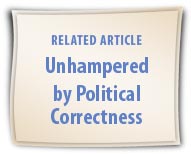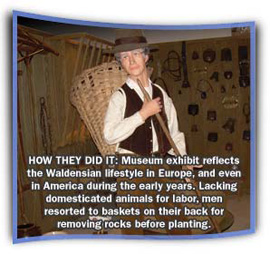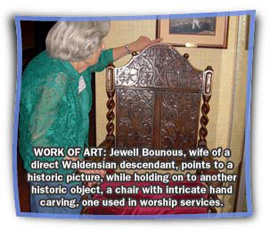 o you ever find your faith waning? Need a reality adjustment? Then take a trip down Interstate 40 in North Carolina to Valdese. There you will meet descendants of God’s faithful . . . still witnessing.
o you ever find your faith waning? Need a reality adjustment? Then take a trip down Interstate 40 in North Carolina to Valdese. There you will meet descendants of God’s faithful . . . still witnessing.
Many who’ve read The Great Controversy, by Ellen G. White, learned for the first time of a maligned people called the Waldensians. There was a time when I imagined the Waldensians—whose history dates back to the eleventh century—as cardboard characters. Unreal, ancient artifacts.
Well, they’re still witnessing . . . here in America where I live.
 Heritage of Honor
Heritage of Honor My first personal encounter was by phone with the Waldensian Museum curator, Gretchen Kostner, a direct descendant of those faithful Christians. I’d discovered the town of Valdese on their Web site and called for information. Talking with her felt almost as good as a trip to Italy. My thoughts raced, pulse pounded.
“Yes, I’ll arrange for an interview on your visit,” she said.
It was a warm afternoon when I arrived in Valdese, with its sun-dappled sidewalks. In the center of town, folk were playing the Italian sport of boccie ball. Some street names sounded Old World—Rodoret, Arnaud, Janavel; and the architecture wore a distinctive European flair, with ample stone and brick construction.
We entered the museum and were greeted by Rheta Robinson, whose Waldensian parents came from Italy in 1920. Jewell Bounous, who married a direct descendant, joined us. These gracious women gave a tour of the museum, highlighting 800 years of Waldensian history.
Arriving in North Carolina in 1893, the group of 200 Waldensians included many stonemasons. They quickly built a church; and children picked up rocks to build a beautiful school that’s still in use today.
Really Up Close
Does seeing a video or reading church history awaken the conscience to truth? Not always, especially in this day of “noisy” electronic distractions and digital enhancements. Today’s skeptics need more.
Well, how about when a living person walks up to you—one whose parents, grandparents, or other close relatives have connections that go way back in time—looks you in the eye, recounts convincing facts, and produces tangibles? When that happened to me, suddenly history came alive, became unforgettable. Who knew you could reach out and touch a Bible from the 1500s—found hidden in a torched Old World wall? Who knew you could see it right here in America?
Relics are interesting, but ultimately it’s the witness of a living person that most profoundly impacts lives.
“What does having a Waldensian heritage mean to you?” I asked.
 Robinson smiled. “Responsibility. It’s very humbling to have this heritage, people who died for their faith. We in this country cannot imagine all they went through. I feel an obligation to our ancestors. What we do here [in Valdese] is not for money, but out of ?a sense of duty.”
Robinson smiled. “Responsibility. It’s very humbling to have this heritage, people who died for their faith. We in this country cannot imagine all they went through. I feel an obligation to our ancestors. What we do here [in Valdese] is not for money, but out of ?a sense of duty.”
So what is it about the Waldensians of Valdese, North Carolina, that makes them witnesses of God’s love? Answer: They demonstrate a history that’s being shoved under a thick rug of lies and denial. They show and tell the truth of God’s leading and of His protecting His loyal followers from an evil system. Though gracious, these modern descendants of the Waldenses don’t mince words. They don’t fear offending. They don’t try to be “politically correct.”
And how do they do all that? Quietly.
The museum, with its gift shop offering many books and videos documenting their journey, is only one part of the town’s message-bearers. You can also travel through eight centuries in Europe by way of the “Trail of Faith,” consisting of 15 open-air exhibits, replicas tracing the religious heritage (from the time of the apostles, many believe) and the pilgrimage of the Waldensians from the Alps of northern Italy to the settling of Valdese in 1893.
These people return often to Piedmont in Italy and stay connected to their faith roots. Each summer the Waldensian story is relived through ?an outdoor drama, “From This Day Forward,” that traces their history.
The Waldensian Presbyterian Church, built in 1899, is an example of Romanesque architecture, with colorful stained glass windows holding seals of ancient Reformed churches of Europe.
“Why Presbyterian?” I asked.
“In the late 1800s we looked for a Christian church without hierarchy, and chose to affiliate with the Presbyterian Church in North Carolina,” said Robinson.
I later researched the subject and found that Waldensian descendants have joined many Protestant churches, including the Seventh-day Adventist Church.
The Waldensian emblem is another way this group preaches softly. It includes words (in Latin) from Matthew 5:16 (“Let your light shine . . .”), a lit candle on a Bible, seven stars depicting the seven churches of Revelation, and a laurel wreath representing the church triumphant.
Journey of Faith
So what did the Waldensians experience? It’s no secret. Visit any great museum of art to see history documented in the form of paintings and etchings. You will find terrible scenes depicted there: burnings at the stake; torture; inquisitions; children thrown off cliffs; caves-of-hiding set ablaze, torching the Christians within. Go ?to any library, read great literary works (poetry and prose) describing the bleak lives and terrible deaths of these people through 800 years and many generations.
What was their crime? Obeying God’s directive “You are my witnesses,” found in Isaiah 44:8. What was their crime? Obeying Jesus, who said, “You are [my] witnesses” (Luke 24:48).
This history is real. Alive today are remnants of a persecuted people who survived rulers calling for their extinction, who survived exile and cruel punishment. And all they wanted was to live in peace, read their Bibles, preach the gospel, and tell the good news of God’s love-gift—His Son.
Quest for Liberty
During a dark period of Catholic dominance, these ?faithful people (called Waldensians by inquisitors because they followed the lay preacher Peter Waldo) vowed to stay true to God’s Word. During a time when only priests were allowed to read and preach, they dared to do both, feeling sure the end of time was near (way back in the eleventh century!).
 They memorized scripture, sewed Bible pages into their clothes, and went about preaching—quietly. Hunted down like wild animals, they were not allowed to hold funerals, own property, or educate their children. Children were stolen and taught Catholicism. Boys and men were kidnapped to be galley slaves on the high seas. Massacres took place (but also miracles). Exiled to Switzerland, many later returned (in 1848) to Italy. Some travels brought encounters with Reformers—Zwingli, Hus, Luther. They encouraged one another.
They memorized scripture, sewed Bible pages into their clothes, and went about preaching—quietly. Hunted down like wild animals, they were not allowed to hold funerals, own property, or educate their children. Children were stolen and taught Catholicism. Boys and men were kidnapped to be galley slaves on the high seas. Massacres took place (but also miracles). Exiled to Switzerland, many later returned (in 1848) to Italy. Some travels brought encounters with Reformers—Zwingli, Hus, Luther. They encouraged one another.
Pastor Alberto Taccia of Italy said in 1988: “The name ‘Waldensian’ does not come from the historic valleys. It belongs to the story of men and women all over Europe who took up a common faith commitment and a common struggle for freedom and the primacy of the gospel of Christ. Historic valley traditions and ties have their place. But we are saved by grace, not by tradition.”
Not all the struggles for freedom in Europe are ancient. Post-World War II Italy saw the rise of the Christian Democratic Party, which refused to implement article 8 of the country’s constitution, designed to protect religious minorities. That party persecuted Seventh-day Adventists, Pentecostals, and others, including Waldensians. Having centuries of training in resistance, the Waldensians brought forth a lawyer, Giorgio Peyrot, who finally—in 1978—succeeded in negotiating change.
Waldensians believe fighting for freedom means fighting for everyone’s freedom.
Follow Faith’s Trail
As Christians, we each have a responsibility to honor our heritage, to be witnesses to God’s love. God has called us to show and tell, not merely the dusty relics of Waldensianism or Seventh-day Adventism, but to proclaim His grace, His biblical truth.
 What has He done for us? Have we shared these experiences with others? Revelation 12:11 says: “They overcame him [the accuser] by the blood of the Lamb and by the word of their testimony.” Our faith is strengthened when shared. We overcome by telling the good news, by proclaiming the covenant of hope.
What has He done for us? Have we shared these experiences with others? Revelation 12:11 says: “They overcame him [the accuser] by the blood of the Lamb and by the word of their testimony.” Our faith is strengthened when shared. We overcome by telling the good news, by proclaiming the covenant of hope.
The words of Rudyard Kipling come to mind:
“Lord God of Hosts, be with us yet,
Lest we forget—lest we forget!”
Waldensians, known as the “people of the book,” embodied faith by living Scripture. Today in Europe they operate large publishing houses, schools, hospitals, homes for the elderly; they provide for many social needs of the populations during disaster, and also for needy immigrants. In America they still carry the torch, providing an amazing living witness to the glory of God in Valdese, North Carolina.
How about the rest of us? Do we identify with a sense of duty? Or do we shirk, by word or action, the responsibility to bear witness to Christ? The Waldensians say, “God is the only answer to a tragic world. We are all equal. There’s no [human] hierarchy—read your Bible.”
And we may add: Look unto Jesus!
__________
Gladys Sherrer is a newspaper columnist writing from Chelsea, Alabama. She is also a member of the Birmingham First Seventh-day Adventist Church. This article was printed January 10, 2010.

![]() o you ever find your faith waning? Need a reality adjustment? Then take a trip down Interstate 40 in North Carolina to Valdese. There you will meet descendants of God’s faithful . . . still witnessing.
o you ever find your faith waning? Need a reality adjustment? Then take a trip down Interstate 40 in North Carolina to Valdese. There you will meet descendants of God’s faithful . . . still witnessing.  Robinson smiled. “Responsibility. It’s very humbling to have this heritage, people who died for their faith. We in this country cannot imagine all they went through. I feel an obligation to our ancestors. What we do here [in Valdese] is not for money, but out of ?a sense of duty.”
Robinson smiled. “Responsibility. It’s very humbling to have this heritage, people who died for their faith. We in this country cannot imagine all they went through. I feel an obligation to our ancestors. What we do here [in Valdese] is not for money, but out of ?a sense of duty.” They memorized scripture, sewed Bible pages into their clothes, and went about preaching—quietly. Hunted down like wild animals, they were not allowed to hold funerals, own property, or educate their children. Children were stolen and taught Catholicism. Boys and men were kidnapped to be galley slaves on the high seas. Massacres took place (but also miracles). Exiled to Switzerland, many later returned (in 1848) to Italy. Some travels brought encounters with Reformers—Zwingli, Hus, Luther. They encouraged one another.
They memorized scripture, sewed Bible pages into their clothes, and went about preaching—quietly. Hunted down like wild animals, they were not allowed to hold funerals, own property, or educate their children. Children were stolen and taught Catholicism. Boys and men were kidnapped to be galley slaves on the high seas. Massacres took place (but also miracles). Exiled to Switzerland, many later returned (in 1848) to Italy. Some travels brought encounters with Reformers—Zwingli, Hus, Luther. They encouraged one another. What has He done for us? Have we shared these experiences with others? Revelation 12:11 says: “They overcame him [the accuser] by the blood of the Lamb and by the word of their testimony.” Our faith is strengthened when shared. We overcome by telling the good news, by proclaiming the covenant of hope.
What has He done for us? Have we shared these experiences with others? Revelation 12:11 says: “They overcame him [the accuser] by the blood of the Lamb and by the word of their testimony.” Our faith is strengthened when shared. We overcome by telling the good news, by proclaiming the covenant of hope.